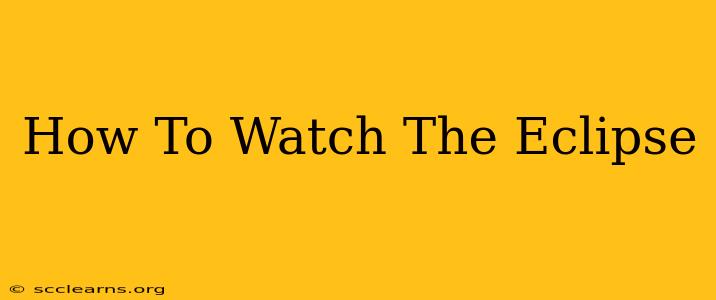Witnessing a solar eclipse is a truly awe-inspiring experience, but it's crucial to prioritize your eye safety. Looking directly at the sun during an eclipse, even partially, can cause serious and permanent eye damage. This guide will walk you through how to watch the eclipse safely and get the best possible viewing experience.
Essential Safety Precautions: Protecting Your Eyes
Never look directly at the sun during a solar eclipse without proper eye protection. This is paramount! Even a small glimpse can lead to solar retinopathy, a condition that can cause blurred vision, blind spots, and even permanent vision loss.
Safe Eclipse Viewing Methods:
-
ISO 12312-2 Certified Solar Filters: These are the gold standard for safe eclipse viewing. Look for glasses or viewers specifically labeled with this certification. They're designed to block out harmful UV and infrared radiation. Do not use homemade filters or sunglasses; these are not sufficient.
-
Solar Eclipse Glasses: These specialized glasses are readily available online and at many science museums and planetariums leading up to an eclipse. Make sure they meet the ISO 12312-2 standard before using them.
-
Indirect Viewing: If you can't get certified solar filters, you can still safely watch the eclipse using indirect viewing methods:
-
Pinhole Projector: Create a simple pinhole projector using a piece of cardboard with a small hole punched in it. Project the sun's image onto another piece of cardboard held behind it. This will show you a projected image of the eclipse.
-
Binoculars or Telescope Projection: Never look through binoculars or a telescope directly at the sun. Instead, project the sun's image onto a white surface.
-
Finding the Best Viewing Location
Your viewing location plays a significant role in your eclipse experience.
Factors to Consider:
-
Totality vs. Partial Eclipse: If you're in the path of totality (where the sun is completely blocked by the moon), you'll witness a far more spectacular event. Check the eclipse path maps to determine your location's view.
-
Weather: Clear skies are essential for optimal viewing. Check the weather forecast for your chosen location before you go.
-
Crowds: Popular viewing spots can get extremely crowded. Consider arriving early or finding a less popular, yet safe, location.
Enhancing Your Eclipse Viewing Experience
Beyond safety, consider these tips for a truly memorable experience:
-
Plan Ahead: Research the eclipse path, find a safe viewing location, and gather your supplies well in advance.
-
Bring a Friend or Family: Sharing this incredible event with loved ones adds to the enjoyment.
-
Capture the Moment: If you have a camera with a solar filter, consider taking photos or videos of the eclipse.
-
Learn About the Science: Educate yourself about the science behind solar eclipses to deepen your appreciation of the phenomenon.
Remember: Safety First!
The most important aspect of watching a solar eclipse is ensuring your safety. By using proper eye protection and following these guidelines, you can safely enjoy this amazing celestial event without risking your eyesight. Don't let the excitement overshadow the importance of protecting your eyes. Happy eclipse viewing!

